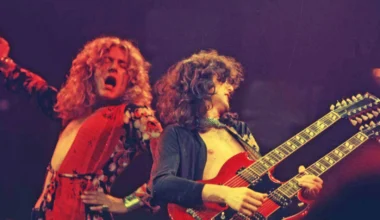Despite his legendary status as Queen’s guitarist and rock icon, Brian May remains remarkably grounded. For May, nothing compares to the raw, authentic thrill of performing live on the roof of Buckingham Palace — without a safety net. Reflecting on that unforgettable experience, May emphasized the profound personal impact over any fleeting fame or celebrity.
The performance took place on June 3, 2002, during Party at the Palace, a grand British pop and rock concert held in the gardens of Buckingham Palace. The event marked Queen Elizabeth II’s Golden Jubilee, celebrating her 50 years on the throne. With 12,000 attendees on site and an estimated 200 million viewers worldwide via television, alongside around a million spectators gathered outside the palace, it was one of the largest televised music events in history.
May’s moment came during the concert’s climax when he played a stunning guitar solo of God Save the Queen live — perched high on the palace roof while an orchestra performed below in the garden. The striking upward shots captured May in full “rock god” mode, the visual cementing this as an iconic moment in British music lore. May meticulously timed his final chord to coincide with the orchestra’s crescendo, raising his fist triumphantly as the guitar’s sound echoed across the palace grounds.
Ozzy Osbourne, another performer that day, called it “the greatest moment of his career,” also praising Queen Elizabeth II as “a beautiful woman,” underscoring the event’s historic significance.
Fear, Focus, and Authenticity: May’s Personal Reflections
In interviews, May has shared how deeply the performance affected him. Speaking to The Guardian, he recalled: “Nothing could ever top playing on the roof of Buckingham Palace with no safety net.” The phrase speaks volumes — a metaphor for the high stakes and genuine risk involved in the live performance, broadcast to an estimated one billion viewers worldwide.
May described the experience as “riveting and terrifying,” admitting the intense fear he felt and the pressure to get every note right. “If it had gone wrong, I would have forever been the guy who messed it up,” he said. To manage the anxiety, he focused on what he could control: hours of practice with the orchestra and trusting a higher power to guide him through the moment.
“This had to be live — you couldn’t fake something like that,” May stressed, highlighting his reverence for authenticity and real-time artistry. The performance became a personal milestone, one that changed him fundamentally: “I felt I’d never be afraid of anything again,” he said, proud of breaking barriers and pushing frontiers in music and performance.
Grounded Despite Global Fame
What stands out in May’s reflections is his grounded nature. Even amid global acclaim, his focus remained on the genuine experience — the fear, the challenge, the raw adrenaline — rather than the celebrity status or public adulation. This perspective offers a striking contrast between the scale of the event and his personal narrative, underscoring his preference for meaningful, high-stakes moments over superficial fame.
With millions watching and an event of historic magnitude unfolding around him, May centered on the intimate battle within himself, reinforcing why this performance holds a unique place in his heart.
A Moment Etched in Time
Brian May’s Buckingham Palace rooftop solo is now etched in music history as a spectacular and daring moment. Yet, it is May’s own words — about fear, authenticity, and personal triumph — that reveal why it was truly unforgettable for him. It was not just a showpiece for a global audience but a once-in-a-lifetime experience that defined his approach to music and life.
In an industry often obsessed with fame and spectacle, May’s story reminds us that sometimes, the most iconic moments come from confronting fear head-on and cherishing the genuine connection between artist, music, and moment.





